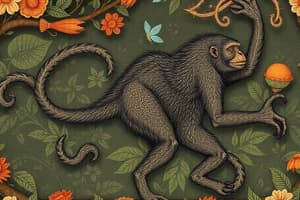Podcast
Questions and Answers
What is the main characteristic that distinguishes humans from other hominoids?
What is the main characteristic that distinguishes humans from other hominoids?
Which of the following is NOT a characteristic of primates?
Which of the following is NOT a characteristic of primates?
Among the given options, which animals belong to the category of hominoids?
Among the given options, which animals belong to the category of hominoids?
What is the closest living relative to humans among the hominoids?
What is the closest living relative to humans among the hominoids?
Signup and view all the answers
Approximately how long ago did the primates exist according to the text?
Approximately how long ago did the primates exist according to the text?
Signup and view all the answers
What distinguishes humans from other primates?
What distinguishes humans from other primates?
Signup and view all the answers
Where did Homo Erectus originate?
Where did Homo Erectus originate?
Signup and view all the answers
Who were the first known members of the Homo genus?
Who were the first known members of the Homo genus?
Signup and view all the answers
Which group of primates inhabit Africa and Asia?
Which group of primates inhabit Africa and Asia?
Signup and view all the answers
What is a notable feature of Neanderthals?
What is a notable feature of Neanderthals?
Signup and view all the answers
Study Notes
- Grasping hands and feet were essential for young primates to cling to mothers, help animals climb trees, and grasp food.
- Early primates divided into Old World and New World groups; Old World primates inhabit Africa and Asia, while New World primates reside in South America.
- Humans are distinguished from other primates by large brains, bipedal locomotion, language use, and complex tool use.
- All hominoids, including humans, originated in Africa around 5-7 million years ago.
- Australopithecus Australopithecus was a bipedal hominid with human-like hands but a smaller brain; lived between 3.8-2.9 million years ago.
- Discovered in Ethiopia, with the famous "Lucy" fossil being over 3 million years old.
- Had an upright posture, with fossils revealing a height of about 3 feet.
- Homo Habilis was the first known member of the Homo genus and the ancestor of modern humans; lived around 1.6-2.4 million years ago.
- Lived in Africa during the same time period as Homo erectus.
- Used tools, as evidenced by the discovery of tools near the fossils.
- Homo Erectus was the first hominin to leave Africa and migrate to other continents around 1.8 million years ago.
- Had an upright stance and longer legs than arms.
- Lived from 1.8 million to 200,000 years ago.
- Used fire and made tools from stone and bone.
- Neanderthals, or Homo Neanderthalensis, were human-like hominins who lived in Europe and Asia until about 35,000 years ago.
- Had a powerful build and distinctive skull features, such as massive skulls and protruding faces.
- Interbred with early Homo sapiens, resulting in Neanderthal DNA being present in non-sub-Saharan populations.
- Modern Homo sapiens (humans) emerged around 200,000 years ago and replaced Neanderthals around 35,000 years ago.
- Humans are the only remaining members of the Homo genus.
- Different hominins coexisted and sometimes interbred, such as Neanderthals and humans.
- Human evolution occurred gradually over a long period, with punctuated equilibrium referring to periods of rapid change followed by periods of little or no change.
Studying That Suits You
Use AI to generate personalized quizzes and flashcards to suit your learning preferences.
Description
Test your knowledge on the evolution of humans and their closest living relatives. Learn about the distinctive characteristics of primates and their categorization within the primate group.




